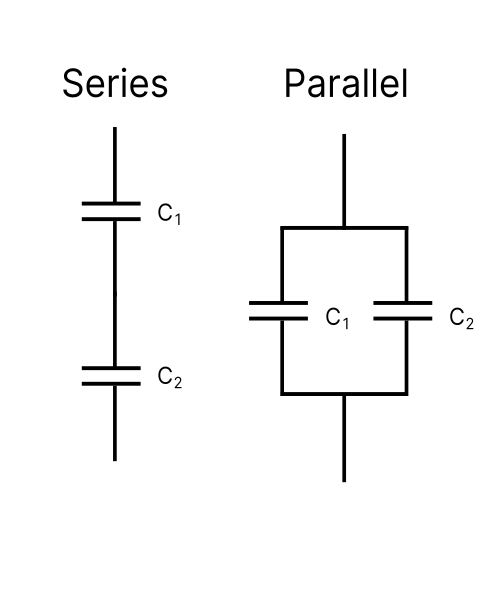
Capacitor C1:
Capacitor C2:
Equivalent Capacitance (Ceq):
Using the Equivalent Capacitance Calculator
Parallel Equivalent Capacitance Calculator
To use the parallel capacitance calculator, set the Series/Parallel option to “Parallel.” Then, under Value to Calculate select the value you wish to calculate. Next, enter the component values into the C1 and C2 fields. To initiate the calculation, press Calculate.
For example, set C1 to 10uF and C2 to 10uF. When click calculate, the equivalent capacitance of the parallel combination will appear in the Equivalent Capacitance box.
Calculating Equivalent Parallel Capacitance
To calculate the equivalent parallel capacitance of n capacitors, simply add the value of each capacitor. You can use the standard parallel capacitance equation below, or use the tool above:

Series Equivalent Capacitance Calculator
To use the series capacitance calculator, set the Series/Parallel option to “Series.” Then, under Value to Calculate select the value you wish to calculate. To initiate the calculation, press Calculate.
For example, enter 11uF into the Ceq field and 22uF ohms into the C1 field. Set the Value to Calculate selection for C2, then press Calculate. It will result in 22uF for C2, letting you know that in order to make 11uF you will need two 22uF capacitors in series.
Calculating Equivalent Series Capacitance
To calculate the equivalent series capacitance of n capaitors, use the standard series capacitance equation:

To calculate the equivalent series capacitance of two capacitors, the equation simplifies to:

For calculating C1, use Equation 4 below. Use a similar equation for calculating C2, with the numbers 1 and 2 swapped:

Rules for Capacitor Values
The parallel & series capacitance calculator tool takes in numbers in integer or decimal form. Use the unit dropdown to choose between the following units.
- p = pico = 10e-12
- n = nano = 10e-9
- u = micro = 10e-6
- m = milli = 10e-3
Meet the Author:

Hi, I’m Dominic. By day, I’m an engineer. By night, I repair and modify guitar effects! Since 2017, I’ve been independently modifying and repairing guitar effects and audio equipment under Mimmotronics Effects in Western New York. After coming out with a series of guitar effects development boards, I decided the next step is to support that community through content on what I’ve learned through the years. Writing about electronics gives me great joy, particularly because I love seeing what others do with the knowledge they gain about guitar effects and audio circuits. Feel free to reach out using the contact form!
